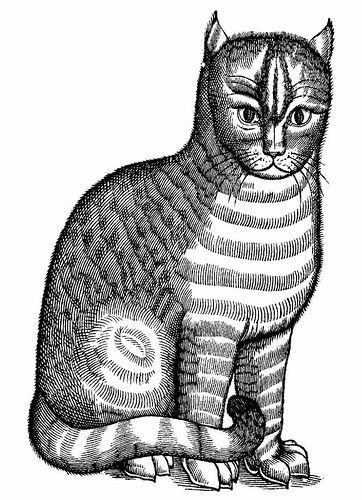I’m not planning to go in the radical carnival direction suggested by The Rhine River, and turn history blogging inside out and upside down, but this Early Modern Carnival might be somewhat different in approach from its predecessors. I’m by training and profession a journalist, so narrative is my thing, although I also have a weakness for the grand theory ala Jared Diamond, and for the oddest of odd facts.
I’m also going to particularly prioritise posts by women bloggers and about women, because I’m a feminist, and I want to. (I made this decision after a Historical Association event at which the audience was about 50/50 male/female, but every person who addressed it — including questioners — was male.)
So to start, a joyfully brisk debunking of the “Shakespeare had syphilis” theory by Majikthise, and Pseudopodium’s exploration of the obstacles Fanny Burney encountered in trying to have her plays performed. This includes a link to the text of her first, The Witlings, prepared from the sole manuscript by the site author. (Browsing around the subject I found the play is to be produced this year.)
While I’m at the theatre, visit Idiocentrism for a biography of Lope de Vega, described without hyperbole as “one of the most prolific writers of all time”. With 1,800 plays to his name, I could almost break my journalist’s rule of always qualifying an absolute to say THE most prolific.
Scribbling Woman, meanwhile, finds two men with the attractive name of William Smellie contributing to the sum of human knowledge, and human existence, in the 18th century. A modern-day doctor is rather less confident, however, as he tries a home visit in 1740.
But you have to be envious, for Barista has found a man who knew everything, including how to interpret hieroglyphs in 1635. Well so he said ….
Charles II didn’t know where one of his favourite dogs was, however, as Prodigies and Wonders reports; it appears the monarch had a trusting faith in canine nature. The Duke of Bedford, however, had great faith in the efficacy of cats as pest controllers, as recorded by Cronaca, a blog that does an excellent job of aggregating history stories in the “old” media.
Carnival mistress extraordinaire Sharon has also been getting bestial, with a look at Cats, rabbits and monstrous births prompted by yours truly, who did a bit of Friday cat blogging not intended for feline fanciers.
This inspired “Ephelia” to recount the sad story of Mary Toft, while Siris took this explanation of monstrous births to a higher level, with a detailed exploration of the early modern view in Malebranche and Seventeenth-Century Views of Heredity.
If you’d prefer a machine, you might like to try one of the automata of the attractively named John Merlin, who might have inspired the young Charles Babbage, on robmacdougall.org.
Less attractive elements of human nature are discussed by Detrimental Postulation in a critique of a popular article finding in Shakespeare the origins of a definition of “whiteness”.
For those who’d like to apply early modern thought to modern conundrums, Ancarett’s Abode, meanwhile, is finding that all students are Little Whigs, while Zippy Zappy She Goes is finding some nasty parallels between the tactics of The Taming of the Shrew and the modern-day Promise Keepers.
But would John Locke have advocated toleration of Islam? Positive Liberty asks, for those who like a mix of current affairs and EM history.
The question “was John Calvin a geocentrist?” probably doesn’t keep you awake at nights. Prosthesis’s post is, however, an extensive and interesting exploration of the historiography of the claim, as well as Calvin’s actual view. Go on; a bit of early modern theology won’t hurt you …
And while I’m being philosophical, Houyhnhnm Land has put up a collection of resources on Lady Mary Shepherd’s Causal Theory, which aimed to establish “the relation of Cause and Effect, which can be securely used, as an efficient instrument in the advancement of science”.
But was the Old Regime of France similar to a Stalinist state? Positive Liberty explores that question via the law against artichoke litter on the Rue des Ecosses.
Leavening the mix, I’ve noticed history blogs are getting increasingly pictorial, and a fine example of this trend is Giornale Nuovo. One post explores the gorgeous pictorial alphabet of Giuseppe Maria Mitelli. If you want to set up your own database, Scribbling Woman can point you in the right direction, while The Social Affairs Unit will be pointing you in the direction of Buckingham Palace, with a glowing review of Dutch Paintings at the Royal Collection.
And if you want to find out where that “luminously mysterious Vermeer, three brilliant Rembrandts, a powerful Hals” et al came from, visit Rhine River’s exploration of the Netherlands’ miracle.
But there’s nothing like a good pun. Chapati Mystery reports on an excellent, although apocryphal, one from 1843, marking a British military victory in Sindh.
Now this may be cheating slightly, since it is actually an old post, but it is at the top of the blog, and I don’t think we’ve had anything from what’s now Slovenia before, so check out The Glory of Carniola.
Moving away from Europe, Regions of The Mind claims to have gone quiet while working on the book, yet still found time to report on the differing differing perspectives on war of the two sides in early colonial America (and lots of other interesting historical issues). God didn’t matter, however, to the Founding Fathers, or at least one treaty so suggests, Ralph E. Luker argued on Cliopatra.
And you think you know when America became independent? No loss for words will set you straight.
Also in America, Mode for Caleb is teaching about the forgotten black abolitionists, while Pratie Place reports how Jewish pirate saved Louisiana.
Heading further from London, Japanese sumo wrestlers were not always the established symbol of the nation that they are today, Far Outliers tells us, while as it gradually drifted away from anything like real combat, alternative forms of military training sprang up.
Frog in a Well, meanwhile, is pondering early modern numeracy, and the question of whether the samurai might have been less numerate than their “lower-class” compatriots.
Bringing the continents together, Chapati Mystery has been been making links across time and cultures, looking at inauguration/coronation ceremonies in Tudor England, for the Nigerian Umundri, medieval India, and of course the one we’ve just had in the US.
I was also looking at historical links in Three degrees of separation, which reports how I found the London district of “Alsatia”, which linked to Thomas Shadwell, who took me to the actress Anne Bracegirdle, at whom I’ve previously arrived from an entirely different direction.
Now who can link Japanese sumo wrestlers to the glories of Carniola in six degrees of separation or less? Answers in the comment field …
The next Carnivalesque, at the start of May, will be hosted by Nathanael at Rhine River, email rhineriverATearthlinkDOTnet . Nominate earlier; nominate often ….
If you’ve inexplicable missed the others, here’s No 1 and No 2. News on future carnivals can be found here.
(And if I’ve made any errors, or missed anything, please tell me. I’ll be happy to make any necessary corrections.)
A tag: [history]



 About
About